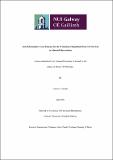Anti-Inflammatory Gene Therapy for the Promotion of Implanted Stem Cell Survival in Infarcted Myocardium

View/
Date
2011-04-13Author
Holladay, Carolyn
Metadata
Show full item recordUsage
This item's downloads: 1506 (view details)
Abstract
Cardiovascular disease is the leading cause of death in the developed world and is
responsible for approximately 36% of Irish mortality. Myocardial infarction (MI), which is
literally the death of cardiac tissue due to lack of oxygenation, accounts for the majority of
deaths associated with cardiovascular disease. This death of cardiac tissue leads to a loss of
cardiac function as the damaged area becomes a non-contractile scar. Reversal of this
process is the main aim of regenerative cardiac strategies such as stem cell transplantation.
While initial studies were promising, subsequent clinical trials yielded disappointing results.
Stem cell therapy may be limited by the poor survival rate of the cells after implantation into
the infarcted heart, which is likely due to the inflammatory response. Thus, antiinflammatory
gene therapy with interleukin-10 (IL-10) was proposed as a method to
modulate the inflammatory response due to MI, thereby promoting the survival of rat
mesenchymal stem cells (rMSCs) seeded into a collagen scaffold delivery system. It was
hypothesized that IL-10 gene therapy could be used to increase the retention rate of stem
cells in a collagen scaffold when delivered to the ischemic myocardium. The primary
objectives of this doctoral project were to develop a controlled release scaffold-based gene
therapy system suitable for stem cell delivery to the infarcted myocardium. The efficacy of
this system was evaluated by assessing stem cell retention, overall cardiac function and the
inflammatory response. A crosslinked collagen-based biomaterial was developed and
optimised for rMSC culture in vitro. Non-viral plasmid-dendrimer polyplexes were
optimized for transfection in both two and three-dimensional culture. The release of these
polyplexes from the scaffolds was assessed with a specifically developed fluorescent
detection technique. When cells were seeded into polyplex loaded scaffolds, relatively high
levels of transgene expression were observed for up to three weeks of culture. When the
polyplex-loaded scaffolds were implanted in rat skeletal muscle, increased retention of
rMSCs was observed. This increased rMSC retention was associated with decreased
inflammation and a change in macrophage phenotype from cytotoxic to regulatory.
Similarly, when the polyplex-loaded scaffolds were implanted over the surface of infarcted
rat hearts, rMSC retention was increased, the inflammatory and remodelling responses were
modulated and, most importantly left ventricular ejection fraction ¿ a measure of cardiac
function ¿ was significantly improved. This is the first study to describe a biomaterial
scaffold combined with gene and stem cell therapy capable of improving outcome after MI.
There is significant potential for further development of the technique which could
ultimately represent a step towards the realization of true cardiac regeneration.

